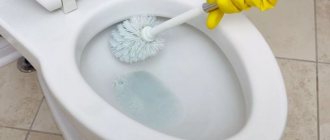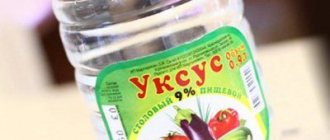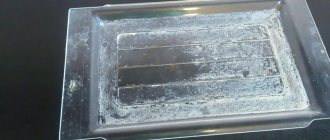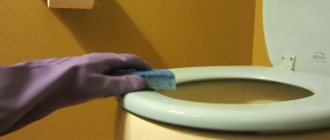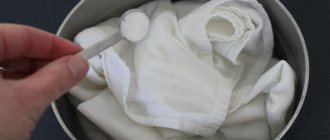In every kitchen and every bathroom there is a device that mixes hot and cold water, called a mixer. On the shelves of hardware stores you can find a wide variety of these devices, differing in design, appearance and cost. Beautiful new chrome faucets give the sink, sink and bathtub an aesthetic appearance, but with regular use, the shine disappears in just a couple of months from the date of purchase. The reason for this is mineral deposits contained in tap water, which over time settle in all areas of the mixer.
In addition to loss of shine, limescale deposits can accumulate in the joints of moving elements, eventually turning into stone formations that can block the movement of valves, as well as creating gaps between parts and gaskets, thereby causing leaks and leading to a situation where the faucet is clogged. Noticing this, housewives are faced with a difficult task - how to clean the faucet from limescale and whether it is possible to use folk remedies.
Important! The rate of plaque deposition directly depends on the water temperature. The hotter the water, the faster plaque forms on the faucet and faucet.
Laying expanded clay concrete blocks
A layer of cement-sand mortar is applied to the pre-waterproofed surface, then laying of the first row begins.
Laying starts from the corner. Moreover, adjacent corners must be connected with fishing line or cord. This will serve as a kind of level. Due to the fact that expanded clay concrete blocks do not have an ideal shape, there is a need to constantly check the horizontal and vertical positions of each row. The construction of walls from expanded clay concrete blocks occurs according to the principle of a designer, the second and subsequent rows are laid with dressing. It makes sense, already in the process of laying the first row of external walls, to simultaneously lay the interior partitions to connect them with the load-bearing walls.
According to the technology, after laying three rows of spoons, the next row is made with a splice row. Thus, the thickness of the wall will correspond to the length of the block. When walls are erected, it is worth filling the block voids with insulation: polystyrene chips or fine expanded clay. Recently, manufacturers have begun to produce three-layer blocks, where the insulation is already installed. This simplifies the work and ensures good insulation of the walls. If your region has a harsh climate, then the external walls can be laid out from two parallel walls, which are connected to each other using reinforcement. Insulation must be poured into the empty space.
Safe traditional recipes
Vinegar and citric acid will cope with limescale deposits
Regular baking soda works well. It is diluted with water to the consistency of a paste, carefully distributed over the contaminated areas, left for an hour, the remaining stains are simply removed with a damp cloth.
If such a remedy does not help, you need to strengthen its formula and prepare another solution. To do this, grate laundry soap, mix the shavings with a small amount of hot water, add a teaspoon of table salt to the finished substance, apply the mixture to a dirty tap, and after half an hour wash it off with a sponge and running water.
Vinegar compresses help get rid of hard limestone. They use 9% acid. Soak a paper towel, then apply it to the faucet, and remove it after a couple of hours. Solid contamination is then easily removed, and the tap is washed with cold water. You can replace acetic acid with lemon juice (two teaspoons per glass of water). It is forbidden to treat shiny surfaces with undissolved composition.
To restore the original shine to chrome parts, you can wipe them with regular baby oil. Apply it to a damp cloth and cover the most contaminated part of the mixer. After an hour and a half, the rag is removed, and the rest of the faucet parts are rubbed with it until shiny. At the final stage, the structure is rinsed with cold water and wiped dry.
When you have nothing at hand, you can clean the faucet with an old brush and toothpaste. The substance is applied to metal parts, left until it hardens, then washed off with water.
The selected product must be used to treat not only the mixer itself, but also the areas around it. Very often, limescale deposits form precisely at the junctions of metal parts. Hard-to-reach places are easier to clean with a toothbrush. It is easier to pick out dirt from the grooves with plastic or wooden toothpicks.
Vinegar
The advantage of vinegar when cleaning faucets from limescale is the speed of its action.
We invite you to familiarize yourself with the Drawings for washing on clothes, interpretation table
Instructions for use:
- mix 9% vinegar and water in equal proportions;
- wet a soft cloth with the resulting solution;
- wipe the surface of the plumbing fixtures;
- leave for a few minutes;
- Rinse the cleaned areas with running water or a damp cloth.
If the contamination is strong, then you can use another method:
- heat the vinegar poured into a container;
- moisten a cloth with hot vinegar and wrap the tap in the area where plaque accumulates;
- wait a couple of hours;
- After the allotted time has passed, remove the compress and wipe the surface with a clean damp cloth.
A vinegar compress can even cope with old limescale deposits.
Use of household chemicals
You can also clean your faucet from limescale using specially designed cleaning products that are sold in every household chemical store. However, there are several very important points to consider when choosing and using chemicals:
In this article, we have shared with you the most effective methods on how to remove limescale from a faucet, and we sincerely hope that following these recommendations will help keep your plumbing clean.
Housewives are well aware of the problem of calcification of chrome-plated plumbing elements. To restore their previous appearance, you have to look for effective means that allow you to remove limescale from the faucet quickly and without damaging its surface.
The cause of limescale is associated with the high content of calcium and magnesium salts in the water. When you open a tap, especially hot water, it produces steam, which condenses and forms a deposit. In the absence of timely care, it crystallizes over time, turning into a persistent white scale that is difficult to remove with regular wiping.
Analysis of the mixer
If you need to clean the inside of the faucet in order to remove deposits on the moving elements, you should first determine the type of faucet. Today mixers are divided into the following types:
- Single-lever - this type is convenient to use in the kitchen, when it is easier to lift the lever with dirty hands than to turn the knobs.
- Two-valve is a convenient option for bathrooms when more precise adjustment of the water temperature is required.
Let's figure out how to disassemble such faucets to gain access to cartridges and faucet axle boxes.
Single lever
To disassemble and clean a single-lever kitchen faucet, follow these instructions:
- Turn off hot and cold water using a faucet or lever under the sink.
- Remove the red and blue plug under the lever.
- Using a thin hex wrench, remove the screw.
- Remove the nozzle with the lever upwards.
- Unscrew the skirt covering the contents of the mixer.
- Use an adjustable wrench to unscrew the clamping nut.
- Remove the mixer cartridge upwards.
- Check the gaskets at the bottom of the mixer cartridge and, if necessary, replace them or the entire cartridge, which are available for sale in plumbing stores.
- After cleaning and replacing, reassemble the mixer in the reverse order.
Two-valve
For disassembling and cleaning a bathroom faucet with a two-valve design, instructions are given below:
- Turn off the cold and hot water taps.
- Unscrew the nuts connecting the mixer to the riser pipes (for chrome-plated parts, the nuts can be wrapped in a damp cloth to prevent scratches).
- Remove the mixer.
- Remove the plugs covering the wing screws.
- Unscrew the screw and remove the wing from the rod.
- Using an adjustable wrench, unscrew the valve axle from the mixer.
- In the same way, remove the second faucet and the switch, which is a ball mixer that transfers the flow of water from the faucet to the shower head.
- Using an adjustable wrench, unscrew the nut securing the gooseneck to the mixer.
- Unscrew the shower hose nut using an adjustable wrench.
- Unscrew the shower head by hand.
- Clean or replace gaskets on the switch, faucet axle boxes and joints of the hose, gander and shower head.
- If the mixer was leaking, replace the faucet axleboxes.
- If the shower head was leaking in the “faucet” mode, the shower switch must be replaced.
- Clean all elements from rust and deposits with detergent.
- Reassemble and reinstall the mixer in the reverse order.
A quick way to clean faucets and showerheads
When carrying out general cleaning in the bathroom, the main efforts must be made to remove the dense limescale layer from the surface of the bathtub, sink and tiles. There are quite a few effective approaches, but to get the maximum positive result, it is recommended to use the following:
- To quickly clean ceramic tiles, you need to spray 6% vinegar on the contaminated area using a spray bottle, wait a few minutes and remove the softened deposits with a soft brush or thick sponge.
- Vinegar will also help restore a heavily soiled sink. Heat a glass of 6% product until very warm and pour it into the sink, having previously plugged the drain with a stopper. If the lime layer remains not completely covered, prepare a little more composition. We leave everything overnight, and in the morning we drain the product and all that remains is to clean off the remaining dirt. You can treat the toilet and bathtub in the same way.
- To remove stains that often cover the sink where the faucet is attached, it is recommended to use citric acid. Apply the product in dry form to a damp sponge and gently scrub the pre-moistened contaminated surface, not forgetting to treat the tap and mixer.
The use of these compositions gives a double positive effect - it allows you to efficiently clean tiles, bathtubs, toilets and sinks, while eliminating the unpleasant odors characteristic of the bathroom.
To clean the enamel coating, you can use almost any product, even those containing organic or alkaline solvents. The enamel of steel and cast iron bathtubs is very resistant to their effects. Only those containing sulfuric or nitric acid are prohibited for use. How to properly clean an enamel bath using the product:
- A weak solution of citric acid or table vinegar is sprayed evenly on the surface;
- It is necessary to soak the solution for 10-20 minutes;
- The walls of the bathroom are thoroughly washed with running water.
How to clean a chrome or nickel plated faucet?
Chrome and nickel plated faucet surfaces require a special approach to cleaning and disinfection. The following products can be used to clean the faucet:
Dishwashing liquid
One glass of warm water should be mixed with a tablespoon of detergent. Next, soak the sponge in the solution and carefully clean the parts of the product.
You need to pay special attention to the base, spout, valves and faucet levers
Baking soda
How to remove rust from a chrome faucet in the bathroom with regular soda? Using a soft, damp sponge or cloth, spread baking soda over the dirty surface and leave for half an hour. Then rinse off with cool water.
White vinegar
6% white vinegar is poured into a container with a sprayer and distributed over the chrome and nickel plated surface of the product, dissolving mineral deposits. Do not touch the vinegar drops for 10 minutes. Wipe the mixer with a dry soft cloth.
Cleaning taps made of precious metals
Plumbing fixtures made of bronze, copper and brass attract with their unusual shine and original appearance. But on such surfaces any dirt and flaws are especially noticeable. These faucets tarnish quickly and require more careful and frequent polishing than chrome faucets. Otherwise, they lose their shine and attractiveness.
There are special household chemicals available for cleaning and polishing faucets made of precious metals. But each type has its own care secrets and improvised means available at home:
- Brass taps are cleaned with a cloth soaked in a soapy solution, a mixture of lemon juice and salt or vinegar and salt. The salt must be well dissolved so as not to scratch the surface. The brass coating “loves” polishing with linseed oil.
- Copper also responds well to cleaning with lemon and salt. But deposits on copper faucets can be removed by boiling in water with the addition of vinegar or dishwashing detergent, after dismantling the structure.
- Bronze faucets are subject to patina. If this effect is undesirable, bronze should also be regularly cleaned and polished with special products or a mixture of water and chicory powder. The mixer, dismantled for cleaning, can be boiled in pea broth.
- For all three types of mixers, cleaning with tomato paste gives a good effect. The applied paste is kept on the surface for up to 30 minutes and washed off with water.
- To polish brass, bronze and copper taps, use professional products, jewelry compounds or GOI paste.
Note: When cleaning and polishing brass, bronze and copper faucets, avoid strong friction with any tools or materials.
Aerator maintenance and cleaning
If the water pressure decreases while using this nozzle, you should check the condition of the aerator. As a rule, the cause of such a negative phenomenon is a clogged filter mesh. In this case, you only need to clean the product, but if it is very clogged and there are defects on its surface, you need to purchase a new faucet aerator.
Let's look at the procedure for cleaning the part.
- Remove the aerator using a mechanic's wrench or pliers. To do this, you need to grab it with a key and turn it clockwise.
To eliminate the possibility of scratches on the faucet cover during dismantling, you should first wrap the head of the product with electrical tape.
- Pull out and assess the condition of the rubber gasket. Next, you need to remove the mesh filter from the cylinder and rinse it under running water, and also thoroughly clean the device using a needle or thin awl.
In case of severe indelible contamination, the aerator is chemically cleaned. To do this, the mesh filter is placed in apple cider vinegar and kept until the deposits are completely dissolved.
- Assemble and install the aerator in its original position. After this, you should check that the part is installed correctly. Namely, open the water and check the connections for leaks; if a leak is detected, you need to tighten the aerator using pliers.
If the above procedures for cleaning the aerator do not bring the desired result, replace it. To do this, unscrew the old device using a wrench, then install a new one in its place. This process will not take more than 20 minutes, and a properly equipped faucet will reduce water consumption by 15%, thereby reducing the consumption of the family budget.
To wash a chrome surface, they use not only industrial products, but also wash it the old fashioned way with soda, vinegar or citric acid. When choosing household chemicals, you need to read the composition; faucets cannot be washed with products containing active acids, alkali and chlorine, as this will cause the coating to become cloudy and covered with dark spots. Below we will talk about how to clean the faucet from limescale without damaging the chrome layer, how to restore the damaged coating, clean the aerator, shower holes and what to do if the faucet is jammed.
The cause of limescale deposits is calcium and magnesium salts, which are contained in excess quantities in tap water. A whitish coating spoils the appearance of plumbing fixtures and sometimes even leads to faucets jamming and shower head openings becoming clogged with scale flakes.
Soap deposits and limescale are not a big problem, even if the holes in the aerator or shower head are clogged. Any housewife can cope with this task on her own without the help of a plumber.
It is much more difficult to choose the right products to care for chrome surfaces in the kitchen and bathroom. Mistakes in choosing household chemicals can result in a dull surface, scratches and black spots; it is very difficult to restore such plumbing fixtures. You will have to put up with the damaged coating or replace all the damaged parts with new ones, which will cost a pretty penny. How to choose the right product:
- Never scrub plumbing fixtures with steel wool, even if it seems to you that all other means will be powerless. It only seems like it to you!
- The product should not contain abrasive particles; the only thing that can be used is a paste of baking soda or table salt.
- Products containing acids will spoil the chrome surface, black spots will appear on it, and a little later, possibly rust. Particularly dangerous are hydrochloric, phosphoric and sulfuric acids, as well as chlorine and alkalis. But vinegar and citric acid will not ruin your plumbing; they can be used without fear. If, as a result of the wrong choice of cleaning products, your taps have already suffered, then at the end of the article you will find a recipe that will help mask the traces of inept handling of household chemicals.
- Do not mix different industrial products with each other, otherwise you risk getting an unpredictable result.
- When choosing a product, make sure that it is suitable for chrome-plated products, and strictly follow the instructions during use.
Features of choosing products for various materials
When cleaning faucets, consider the coating material. Some products may damage the top layer of the device. Strong acids and chlorine compounds react with metal, abrasive materials leave scratches that become centers of corrosion.
Bronze and brass
In case of severe contamination, it is recommended to prepare a mixture of available products: flour, fine salt and vinegar .
The ingredients are taken in equal proportions - 1 tablespoon each. The resulting composition is used to treat contaminated areas and leave for 10-15 minutes. The mixture is removed with water, and the bronze is polished with a soft cloth. To maintain shine and prevent plaque, you need to wipe the faucet with linseed oil once a month.
Stainless steel
From household chemicals it is recommended:
- Foam Dr. Beckmann - quickly dissolves salts, removes contamination, protects metal from corrosion.
- Frosch - an environmentally friendly universal cleaner removes soap residue, stubborn deposits, and rust.
- Dual power - the spray effectively cleanses water stone, rust, and soap residues.
Stainless steel is resistant to most household cleaning methods. You can restore its purity and shine using recipes with soda, vinegar, citric acid, and mustard powder.
Chromium-plated
Stainless steel or brass taps are coated with a layer of chromium to ensure corrosion resistance. The coating is thin and is easily damaged by mechanical stress. When cleaning, do not use abrasive products. Daily cleaning is done with liquid soap, followed by wiping dry.
To combat salt deposits, you can take a weak solution of vinegar or citric acid . They are applied to the surface for no more than 10 minutes. When purchasing household chemicals, you need to make sure that they are intended for chrome surfaces.
Nickel plated
Nickel-plated faucets are sensitive to mechanical damage. When cleaning, avoid rough brushes, sponges and abrasives. Wiping with vinegar, a mixture of laundry soap and soda will get rid of plaque. glass cleaner will help make metal shine . It is allowed to use ammonia to remove rust. The substance is applied with a soft sponge. After washing off the ammonia, the surface is treated with oil.
To avoid damaging the surface of the mixers during operation, do not use:
- metal scrapers and brushes that scratch metal;
- aggressive acids: hydrochloric, sulfuric, phosphoric, leading to the appearance of dark spots;
- mixtures of several chemicals;
- abrasive compounds.
Before cleaning, be sure to wear rubber gloves to protect your skin from exposure to chemicals.
Ways to get rid of limescale deposits on the toilet
- The best way to remove minor lime deposits is with such irreplaceable products as citric acid, vinegar and chlorine in the form of bleach. These products can be reused if they do not work the first time. It should be taken into account that all traditional methods do not work as quickly as store-bought ones and require considerable effort.
- If the plaque has accumulated over many months and does not respond to specialized drugs, all hope remains for potent drugs. Among them are oxalic acid and electrolyte.
There are also some effective non-traditional remedies, for example, Coca-Cola.
Coca-Cola is not only tasty, but also effective in cleaning the toilet from limescale.
How to use citric acid
- Take 2-3 sachets of citric acid.
- Apply the substance to problem areas.
- Close the toilet lid and wait 3 hours.
- Work well with a brush and rinse with water.
How to remove limescale with Coca-Cola and citric acid - video
Step-by-step instructions for cleaning a toilet with vinegar
To clean the toilet with this product you will need:
- 1 glass of 9 percent vinegar;
- 2 tsp. baking soda.
Operating procedure:
- Pour vinegar into a saucepan.
- Heat the liquid to approximately 40 °C.
- Add soda.
- Pour the sizzling solution onto the lime-covered areas.
- After 8 hours, wash off the mixture along with the plaque with warm water.
Using products available in every kitchen, you can effectively remove limescale from the surface of the toilet bowl
How to clean a toilet from heavy limescale with vinegar - video
How to use Whiteness correctly
- Dry the inside of the toilet with a rag and absorb water from the drain.
- Fill the bottle with Whiteness and do not use the toilet for 12 hours, but be sure to close it with a lid so that harmful fumes remain inside.
- When the plaque softens, immediately rinse off the product with water and then clean the toilet.
The easiest way to clean a toilet from plaque - video
Features of cleaning the tank, lid and toilet seat
To clean the tank, first turn off the water tap and then drain the water from the device. You should use a neutral product without acids, which can destroy rubber and plastic elements. To prevent plaque, special hard plates should be attached to the wall of the tank. To clean the toilet seat and lid, choose a detergent with a minimum of alkalis, acids or chlorine, because the remains of aggressive substances can cause a chemical burn on the skin when using the toilet.
Removing plaque with oxalic acid
The substance in the form of a dry powder can be purchased at a hardware store. It belongs to carboxylic acids and has moderate toxicity. The exposure time of the substance must be strictly observed so that it does not have time to corrode the enamel. However, this acid ensures the impeccable whiteness of the toilet bowl, even if it is not used in its pure form, but as part of any products. Before using them, you should carefully study the instructions for use and take all safety precautions specified therein. In particular, be sure to wear thick rubber gloves.
- Take a piece of cloth and dampen it.
- Pour the powder onto a cloth and wipe all areas with limescale formation (to clean the drain, the powder is dissolved in the water remaining in it).
- Wait one hour.
- Use a brush and water to clean off the deposits.
An effective way to clean stubborn limescale is to use oxalic acid in its pure form or products based on it.
Electrolyte for toilet cleaning
Battery electrolyte is one of the most effective, but at the same time the most dangerous means for getting rid of limescale, as it can leave chemical burns. To use it, get all the personal protective equipment - a rubberized apron, a respirator, safety glasses, thick rubber gloves.
- Pour the electrolyte very carefully onto areas with lime deposits, avoiding splashing of the product.
- Close the toilet lid and wait 15 minutes.
- Wash off the electrolyte along with the deposits with plenty of water.
Electrolyte is an effective but dangerous means of removing limescale.
Cleaning agents for removing limescale
For adherents of household chemicals, the market offers a huge selection of cleaning products for cleaning faucets or mixers from limescale.
Tip: when buying a special powder, carefully study the label. Otherwise, there is a risk of saying goodbye not only to plaque, but also to your own plumbing.
Anti-corrosion inhibitors
Cheap detergents do not contain valuable anti-corrosion inhibitors. Inhibitors prevent aggressive additives from damaging the metal. With them, the entire attack is aimed exclusively at lime deposits. Therefore, look for anti-corrosion inhibitors in the composition of the product.
Sulfuric, hydrochloric or nitric acids
Acids are rather heavy artillery for cleaning faucets. They decompose not only plaque and rust, but also enamel and metal coatings. Products with such acids can only be used in advanced cases and only when wearing gloves.
For daily treatment, it is better to choose softer products - based on surfactants.
. When released into water, they are almost completely biodegradable and do not damage the skin of the hands.
What to choose: liquid or cleaning agent?
The powder has an abrasive structure and is best used for cleaning bathtubs and sinks. It is better to entrust the care of metal surfaces to liquid products. Apply the product to the surface, leave for 5 - 10 minutes, rinse with water. And enjoy the shine!
Tap water contains minerals, which determine its hardness and the faucets' hardness during operation.
Impurities settle on pipes and taps, and limescale forms. Faucet care includes not only daily wiping of moisture, but also regular cleaning of mineral deposits inside and outside.
Causes of plaque
Plaque on plumbing appears due to increased water hardness, which is determined by the concentration of mineral salts. As a rule, calcium and magnesium salts predominate in the water supply. Mixing with soap suds, they leave white marks and streams on surfaces. When the content of iron salts in water is high, a yellow precipitate is formed.
But the untidy appearance of the faucet is only an external manifestation of the problem. Limescale deposits are also deposited on the internal surfaces of faucets - after all, there is always a certain amount of water there. In advanced cases, water stone forms on the moving parts of the structure, which disrupts the operation of the taps and can cause them to fail. Moreover, the rate of deposit formation directly depends on the frequency of use of hot water. At temperatures above 70 °C, salts settle much faster, forming scale. This problem is usually typical for boilers and washing machines, but can also affect faucets. Therefore, it is necessary to promptly clean them not only outside, but also inside.
Preventive actions
Even with increased water hardness, contamination of the faucet will not be a problem if you properly care for your plumbing equipment. For example, you can use the following methods:
- install filters for water softening;
- install coarse and fine mechanical filters;
- Use suitable cleaning products;
- remove lime deposits while they are fresh;
- cover external surfaces with a special shampoo, which forms a film that protects against contamination.
Then maintaining the good condition of the equipment will not be a hassle.
Using the techniques described, any skillful owner will be able to clean the faucet. To do this, you need a screwdriver, a wrench and a special tool for removing rust and lime deposits. The main thing is to remember to turn off the hot and cold water shut-off valves before starting work. All these efforts will not be in vain. A smooth, powerful stream from the tap will help you do all your household chores quickly and easily.
Every person at least once in his life has encountered the problem of how to remove limescale from a tap, but few people have thought about the true reasons for its appearance. The fact is that the water that is supplied to our houses and apartments through pipeline systems always contains various mineral impurities. Their number may vary depending on the area of residence, but they still exist and have a direct impact not only on water hardness, but also on the formation of unpleasant deposits on the internal and external surfaces of pipeline equipment. In this article we will tell you how to clean limescale from your faucet at home and how to avoid further contamination.
Traditional cleaning methods
To clean the mixer, it is not recommended to use aggressive compounds containing acids, as well as chlorine. There are several folk recipes that offer to get rid of plaque and rust using products that every housewife has in her home.
Removing limescale from faucets using vinegar
You need to take:
- gloves;
- 7% vinegar;
- an old toothbrush;
- wire or paper clip;
- a basin with a rag to remove deposits.
- First, remove the shower head. If this is difficult, use pliers, but be sure to wrap a cloth around the reflective surface of the plumbing first to prevent scratches. If possible, remove the shiny cover and leave only the shower head.
- Place the shower head in a bowl of vinegar heated to 50 degrees. Don't forget to wear gloves.
- If you can’t remove the faucet, experienced housewives advise pouring vinegar into a plastic bag and putting the faucet there. The shower nozzles must be completely submerged in vinegar. Secure the bag with a paper clip or wire. Soak the plumbing fixtures in vinegar for 15-20 minutes.
- After soaking, clean the limescale deposits using a stiff bristle brush.
- Next, rinse the treated plumbing fixtures in hot water.
This simple folk recipe will help remove lime from the surface of the shower head.
To remove lime deposits from a faucet, you can use the following tips from housewives:
Lemon in the fight against lime
- Cut off the lemon rind with a knife.
- Rub the mixer with it.
Over time, the lemon juice will dissolve the lime, and all you have to do is rinse the area with water and wipe with a towel.
Baby oil against limescale and soap scum
You can remove limescale deposits on the faucet or soap deposits from the faucet using baby oil.
- Apply the product to a soft cloth and rub the dirty areas with it.
- Then polish the surface with a dry towel.
Application of vinegar essence
Do not confuse it with table vinegar; you will need acetic acid with a concentration of 70%.
- Dilute the essence in water in a ratio of 1:20.
- Depending on the density of lime deposits, the temperature of the solution will also increase.
- We recommend cleaning faucets with a metallized coating with vinegar diluted in boiling water.
Fighting lime with oxalic acid
Housewives often use oxalic acid to remove or wash lime deposits.
- Before use, the acid must be diluted in warm water. The solution itself should be five percent (for 1 part acid, take 20 parts water).
- Apply the solution with a brush to areas of the shower head affected by plaque and leave for 3 hours.
- Next, rinse off any remaining plaque with water.
Soda
Regular baking soda is used as follows:
- dilute baking soda in a small amount of water;
- Apply the resulting slurry to areas of the faucet damaged by plaque;
- wait an hour and rinse the surface with warm water.
Helps only with fresh plaque.
Salt
Table salt must be dissolved in water until it becomes pasty. Then pour onto a napkin and rub onto the contaminated areas. Wipe off after 20 minutes.
Laundry soap
It should be soap with the 72% mark. Algorithm:
- grate a third of the piece on a coarse grater;
- dilute with hot water to a liquid cream;
- treat the surface of the mixer with the composition;
- leave for 20 minutes.
Then rinse with water. To enhance the effect, you can add a tablespoon of soda to the cream.
Lemon acid
It can be natural lemon juice or powder, but it is also natural. Dissolve in water in a ratio of 1:1.
- apply from a spray bottle;
- leave for 45 minutes.
Rinse off.
Window cleaner
In addition to windows and mirrors, these compounds perfectly remove limescale. It is better if ammonia is among the ingredients.
An excellent method, but it only works for fresh plaque. These wipes do not scratch the chrome surface.
Coca Cola
The recipe has been tested by many housewives:
- soak a piece of cloth in soda;
- place as a compress on the mixer;
- wait 20 minutes;
- Wash the surface from any remaining soda and deposits.
At the end of the procedure, wipe the entire mixer with a dry cloth.
Ammonia
This is a method using a glass cleaner. You need to add ammonia to it. Then spray the entire mixer with the mixture and after 20 minutes, rinse everything off with warm water.
How to clean bronze faucets
Bronze faucets have a special noble matte shine. However, over time, due to contact with water and moisture, they fade and lose their original shine.
A mixture of vinegar, salt and flour effectively cleans bronze taps and returns them to their original appearance. To make the mixture, you need to mix one spoon each of flour, salt and 6% vinegar. This mixture is applied to contaminated areas with a damp cloth and then washed off with warm water. The final stage is wiping with a clean, dry cloth.
A darkened bronze mixer will bring regular tomato paste back to life. Cover the stains on your faucet for half an hour and then rinse with warm water. The result will pleasantly surprise you.
Flaxseed oil is an excellent preventative against tarnish and darkening for bronze water taps.
An ordinary lemon, cut in half and sprinkled with fine salt, will return bronze faucets to their former shine and beauty.
Chicory powder has proven itself well in cleaning bronze mixers. A cleaning composition consisting of three tablespoons of chicory and warm water is applied to the contaminated areas, then washed off and the surface of the faucet is wiped until shiny with a soft, dry cloth.
If these folk remedies do not help in the fight against plaque and stains, then a special paste will come to the rescue - Trilon-B.
We recommend the product
Mixer Imprese Daicy 55009-U 2 reviews
In stock
Type: double lever | Type: mixer | Material: brass | Height, mm: 343 | Purpose: for the kitchen | Equipment: faucet |
Cleaning plumbing fixtures
In addition to cleaning chrome taps, other plumbing fixtures also require cleaning: shower heads, darkened areas of appliances, as well as buttons on the toilet, cabinet fittings.
For cleaning, improvised means are also used, and if they fail, household chemicals come to the rescue.
Cleaning the shower head
It is important to clear clogged holes in the shower head in a timely manner, before they are completely covered with lime flakes. To do this, try to disassemble the shower head
Soak the parts that were removed from the structure for 2 hours in a heated vinegar solution. After this, rinse them with water to remove the odor.
The hydromassage nozzle itself must be cleaned using a needle. It is also recommended to use some chemical compounds and clean the injectors with a toothbrush.
Recipe for cleaning darkened plumbing fixtures
Unfortunately, it is often impossible to restore damaged chrome plating. However, there is a tool that helps hide cleaning mistakes. For this purpose, a special composition is used for polishing metal parts of a car, including Goi paste. You can purchase such substances at any auto store, having previously consulted on this issue.
Another method of bringing chrome coatings to a shine is the use of car wax shampoos. They create a water-repellent film on the coating and protect the material from corrosion.
Don’t forget about timely cleaning of chrome taps, and then you won’t have to think about finding suitable products.
Industrial products
If folk remedies cannot cope with the deposits on the surface of the faucet, or their effectiveness is low, you will have to use powerful household chemicals. The disadvantage of chemical compounds is their danger to the skin, so before treating plumbing fixtures you need to take care of personal safety equipment - wear gloves and a face mask. Some substances can cause an allergic reaction, so it is better to familiarize yourself with their composition and the manufacturers' recommendations on the packaging.
On sale you can find a large selection of products for processing chrome and stainless steel products. They are divided into 2 groups:
- Cleaners. Fights heavy pollution.
- Polishes. Used to restore the shine of surfaces.
To improve cleaning, it is recommended to combine products.
The most popular and effective formulations include products from the following companies:
- Top House. It is a popular German manufacturer of household chemicals that produces reliable products for cleaning stainless steel surfaces.
- CILLIT BANG. A Russian manufacturer that produces powerful products to combat plaque on metal surfaces.
- Sanox. Another company from Russia that produces a wide range of products for treating plumbing fixtures.
- Cif. A Hungarian company that offers a lot of effective compounds for combating plaque on metal. They can be used to clean bronze taps.
Popular polishes also include Domax and Indesit. Products from the latest brand produce household appliances, so cleaning products meet all modern standards.
The listed compositions are effective not only when treating chrome surfaces. They can be used to clean sinks, stoves, kitchen fittings and even kitchen utensils. Many models come in bottles with a dispenser nose that allows you to quickly spray the substance.
The drug is left on the surface for some time so that the active components penetrate well into all pores. After this, wipe it with a dry cloth.
Polishing compounds are necessary to restore the mirror shine of metal.
Some products are capable of creating an invisible protective film that makes surfaces resistant to plaque. Glass cleaning chemicals have a similar effect.
How to clean the holes in a shower head?
If the holes of the hydromassage nozzle are clogged, we will use heated vinegar; by the way, vinegar is a universal home remedy that housewives use for various purposes. With its help you can clean rooms and even remove various types of household pollution.
Unscrew the shower head, disassemble it into parts and soak them in heated vinegar for 1-2 hours, after which, armed with a darning needle, thoroughly clean all the holes and reassemble everything as it was. Instead of vinegar you can use " CilitBang"
"and an old toothbrush. When the limescale is finished, reassemble the watering can and attach it back to the hose.
Wax shampoo
Some housewives have found a way to not only clean the taps, but also protect chrome parts from limescale for a week. To do this, they use waxy car wash shampoo. This product is designed to protect the car body from adverse weather conditions. The wax included in the shampoo forms a thin water-repellent film on the surface, protecting the metal from corrosion. You can buy wax shampoo at any auto store.
Apply a drop of shampoo to the sponge and thoroughly wash all chrome surfaces in the kitchen and bathroom. Polish with a soft cloth or microfiber cloth to a mirror shine. That's all, you can forget about limescale for at least a week.
Is it possible to avoid plaque formation?
It is impossible to avoid the appearance of plaque inside the faucet. Although in different regions of our country water has different hardness, it still contains a certain amount of magnesium and potassium salts, which form plaque.
But it is quite possible to restore external beauty and shine if you make it a rule to wipe the faucet after use. A napkin or the soft side of a sponge is suitable for this purpose.
Tap water always contains minerals. In some regions there are more of them in the water, in others there is much less, but they are definitely there. Not only the hardness of the water, but also the condition of your faucet depends on their quantity. It is because of mineral salts that whitish spots of dull limescale appear on the shiny surface of a chrome faucet. No self-respecting housewife will leave this disgrace unattended. How to clean a bathroom faucet without damaging its surface?
The nuances of cleaning the aerator
An aerator is a special mesh that is found in taps to spray water from the tap. Before cleaning it, remove it and inspect it for various contaminants. If there are too many of them, then use a vinegar solution in which the part should be soaked for 40 minutes.
To reduce cleaning time, it is recommended to wipe off the water with a napkin or a well-absorbent piece of cloth each time after using the tap. Many people don’t do this and remember only when the plaque has already formed. However, it is still possible to clean limescale from your faucet when you only have home remedies at hand.
You can remove dirt:
- laundry soap;
- baby oil;
- baking soda;
- table vinegar;
- citric acid;
- lemon;
- drink "Cola".
The advantage of this method is its safety for health and good effect. First of all, you need to grate a piece of soap on a grater with large holes. Then put grated soap in a container and pour boiling water over it so that you get a mass with the consistency of thick sour cream. Add soda (baking or soda ash) to this mixture.
This oil perfectly removes not only soap stains, greasy stains, but also fresh limescale deposits.
The cleaning technology is quite simple:
- Pour a small amount of baby oil onto a soft cloth, wet it completely.
- Wipe the areas where there is plaque.
- Wash off the oil with warm water from the surface.
- Using suede, flannel or flannel, polish the product.
What to do if the faucet is jammed due to plaque
Sometimes it happens that due to plaque that has not been removed for a long time, the faucet begins to jam. In this case, we suggest using one of two effective methods.
Vinegar solution
When the faucet stops working due to salt deposits, it must be removed and soaked in a vinegar solution. Please note that it should not be too concentrated, so mix the components in a ratio of 1 measure of vinegar and 3 measures of water.
This solvent is recognized as one of the best, and it is often used not only for domestic purposes, but even for industrial purposes. In order for the faucet to start working, you will have to perform an aerosol treatment of all places where a lot of salt deposits have formed.
